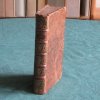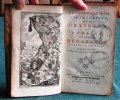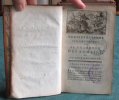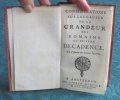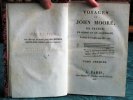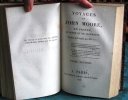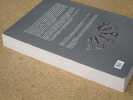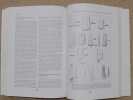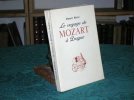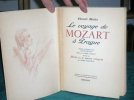-
Type
Art print (1)
Book (6740)
Disk (1)
Engraving (79)
Magazine (371)
Maps (439)
Music sheets (1)
Old papers (1)
Photographs (9)
Posters (1)
-
Latest
Last 24h (4)
Last 3 days (5)
Last month (61)
Last week (72)
-
Language
Dutch (9)
English (3)
French (7627)
Italian (1)
Latin (1)
Portuguese (1)
Spanish (1)
-
Century
16th (55)
17th (114)
18th (273)
19th (733)
20th (2361)
21st (567)
-
Countries
Belgium (1012)
Canada (4)
China (1)
Côte d'Ivoire (2)
France (6165)
Italy (47)
Netherlands (1)
Switzerland (411)
-
Syndicate
ALAC (4)
CLAM (14)
CLAQ (1)
ILAB (3341)
NVVA (291)
SLACES (291)
SLAM (2976)
Considérations sur les Causes de la Grandeur des Romains et de leur Décadence.
Nouvelle édition à laquelle on a joint un Dialogue de Sylla et d'Eucrate.A Paris, chez Moreau - 1755 - 365 pages. Frontispice par Eisen et De la Fosse. Une vignette de chapitre.Reliure plein veau marbré de l'époque. Dos à nerfs orné et doré. Pièce de titre maroquin rouge. Titre en rouge et noir. Tranches rouges. Tampons. Léger accident à la coiffe supérieure. Coins émoussés. Pas de rousseur. Intérieur frais. Bon état. Format in-12°(17x10).Considérations sur les causes de la grandeur des Romains et de leur décadence, également connu sous le titre Grandeur et décadence des Romains, est une oeuvre de Montesquieu, rédigée en 1734, évoquant la Rome antique, ses forces politiques, ses abus et les causes de sa chute.
EISEN Charles
Considérations sur les Causes de la Grandeur des Romains et de leur Décadence.
Par l'Auteur des Lettres Persanes (Montesquieu).A Amsterdam, chez Pierre Mortier, 1734 - 272 pages. Édition parue la même année que l'originale.Cartonnage postérieur orné à la bradel. Étiquette de titre rouge au dos. Pas de rousseur. Très bon état. Format in-16°(15x9).
Lettres familières du Président de Montesquieu,. baron de La Brède, à divers amis d'Italie.
S.l., 1767; in-12, 285 pp., f. 95-96 présentant des traces d'humidité, basane fauve marbrée, dos à nerfs cloisonné et fleuronné, tranches marbrées (reliure de l'époque). Dos frotté, avec dorure passée.
Notre édition, datée de 1767 comme l'originale, ne correspond pas à la collation donnée par Tchemerzine (à savoir [2] ff. n. ch. et 264 pp.), mais elle contient quand même deux lettres (les LIV et LV) dirigées contre Madame Geoffrin (sur trois ?), si bien qu'il est difficile de préciser sa position dans l'histoire éditoriale de ce texte posthume.L'on sait que, vexée, la salonnière fit rechercher et détruire tant qu'elle put des exemplaires de l'édition originale ; mais ce tirage fut-il concerné ? Cf. Tchemerzine-Scheler IV, 931 (pour l'originale). - - VENTE PAR CORRESPONDANCE UNIQUEMENT
Oeuvres de Monsieur de Montesquieu, nouvelle édition, revue, corrigée, et considérablement augmentée par l'auteur.
A Amsterdam, et à Leipsick, Chez Arkstée et Merkus, 1758. 3 volumes in-4 de [4]-LXXXVI-527; [4]-XVI-634; [4]-648 pages, plein veau marbré, dos à nerfs ornés de filets et fleurons dorés, étiquette de titre et tomaison rouge et brune, tranches marbrées.
Illustré de deux cartes géographiques dépliantes (mappemonde et Europe) et d'une en-tête par de Sève. "Edition publiée par Richer, avocat au parlement, d'après les manuscrits communiqués par la famille et les changements proposés par l'auteur lui-même, et imprimée par Moreau, ancien secrétaire de Montesquieu, célèbre par son érudition, qui corrigea les épreuves." Vian, p. 24. Rousseurs.
Notes sur la Roumanie
Nouvelle Librairie Nationale 1914, in-12 broché, 109 p. (plusieurs manques au dos ne remettant pas en cause la solidité du volume, sinon bon état) Sur bon papier ; avec 16 planches de photos HT. Rare étude de ce pilier de l'Action française, montrant que ce pays avait été sauvé par la monarchie.
Les Bouches à feu de l'artillerie suisse. 1819-1939
Lausanne, Editions du Centre d'Histoire, 1980 in-8, 171 pp., ill. in-t., planches, broché. Des passages soulignés au stylo rouge. Ex-libris Collection Ulrich.
- - VENTE PAR CORRESPONDANCE UNIQUEMENT
La Pucelle (roman).
Belgique, France Loisirs, 1988. 16 X 23, 749 pp., 7 cartes, cartonnage d'édition + jaquette, très bon état.
roman historique.
Vermeer and His Milieu: A Web of Social History
Princeton University Press 1991 476 pages 15 2x3x22 6cm. 1991. Broché. 476 pages.
Bon état rousseurs sur la tranche intérieur propre bonne tenue
La torre della Ghirlandina
AEDES MURATORIANA 1976 Livre en italien. In-4 relié 31 cm sur 21,5. 329 pages. Piccolissima graffio sulla parte inferiore della sovraccoperta in corrispondenza col dorso. Immagini in bianco e nero dentro e fuori dal testo. Très petite éraflure sur le dos de la jaquette. Images en noir et blanc dans et hors texte. Jaquette en bon état. Sinon très bon état d’occasion.
Libro estremamente completo sulla storia dell’iconica torre medievale modenese. Livre très complet sur l’histoire de la tour du moyen-age de la ville de Modena. Bon état d’occasion
100 Fiches pour comprendre l'Union européenne: 2e édition
BREAL 2020 346 pages 15 8x23 8x2 4cm. 2020. Broché. 346 pages.
Bon état - . légères marques de stockage sur couverture et coins mais du reste en bon état - envoi rapide et soigné dans enveloppe à bulles depuis france
Voyages nouveaux par mer et par terre effectués ou publiés de 1837 à 1847 dans les diverses parties du monde contenant la description de ces contrées, les moeurs, coutumes, gouvernements, cultes, production, industrie, commerce, etc., analysés ou traduits par M. Albert-Montémont... Tome 5. Voyages en Europe
Paris, A. René et Cie, Imprimeurs-éditeurs 1847 In-8 21 x 12,5 cm. Reliure de l’époque demi-basane havane, dos lisse orné de filets dorés, 408 pp., table. Coupes frottées, intérieur correct.
Contient : Voyages en Russie, Crimée, Hongrie ; Voyages à Constantinople et en Turquie d’Europe ; Voyage en Norvège et Suède ; Voyage en Islande ; Voyages en Italie et Sicile ; Voyage en Morée, etc. Bon état d’occasion
MONUMENTS HISTORIQUES
N° 180 - Mars-avril 1992 : Revue de l'ex Caisse Nationale des Monuments Historiques. 128 pages, format 215 x 270 mm, illustrée, brochée couverture couleurs, bon état
Dossier : "L'Europe des Echanges"
Phone number : 04 74 33 45 19
Le Nil blanc
Gaïa 1995 298 pages poche. 1995. broché. 298 pages.
Bon Etat bonne tenue intérieur propre
A narrative of the campaign of the British army in Spain. commanded by His Excellency lt-gal Sir John Moore, K. B.... Second edition corrected
London, Johnson, 1809 in-4, XII-324 pp., portr., 1 gde carte dépl., 1 litho. h. t. et 1 plan dépl., demi-basane fauve à coins, dos lisse, filets dorés (reliure de l'époque). Manque aux coiffes, début de fente aux mors, coins usés.
Édition originale in-4.Bonne relation anglaise de la campagne d'Espagne en 1808 et du début de 1809.Ex-libris manuscrit sur la page de titre John Curling. - - VENTE PAR CORRESPONDANCE UNIQUEMENT
Voyages de John Moore, en France, en Suisse et en Allemagne. - Édition originale.
Traduits de l'Anglais par Melle.***Édition originale. A Paris, chez Perlet 1806 - viij, 303 et 308 pages. 2 tomes en 1 volume.Reliure demi basane framboise de l'époque. Dos lisse avec pièces de titre et de tomaison noires. Filet dorés et fer en pied. Fleurons à froid. Pas de rousseur. Très bon état. Format in-8° (20x14).
La victoire de Luther . Essai sur l'Union économique et monétaire
Vivarium 2001 In-8 broché 21 cm sur 15,2. 251 pages. Bon état d’occasion.
Bon état d’occasion
Cultures et sociétés du BRONZE ANCIEN EN EUROPE : actes du 117e congrès international des Sociétés Savantes (Clermont-Ferrand, 1992).
Comité des Travaux Historiques et Scientifiques C.T.H.S. Editions du C.T.H.S. (Comité des Travaux Historiques et Scientifiques), 1996, 745 p., broché, environ 30x21 cm. Bords de la couverture frottés, bon état pour le reste et intérieur bien propre.
Merci de nous contacter à l'avance si vous souhaitez consulter une référence au sein de notre librairie.
Réponse de l'administrateur général des Etats de Parme au prédicateur de la cathédrale de Parme.
S.l. [Parme], s.n. [Bodoni], s.d. (1804) in-8, [4] ff. n. ch., en feuilles.
Très rare pièce autorisant Felice de' Vecchi à donner des instructions morales dans la cathédrale de Parme en lieu et place des sermons de Carême. Moreau de Saint-Méry (1750-1819) fut nommé administrateur général délégué des Etats de Parme après le Traité d'Aranjuez du 21 mars 1801 qui prévoyait la cession des duchés de Parme, Plaisance et Guastalla à la France en échange de la constitution du royaume d'Etrurie (Toscane) au profit du fils de Ferdinand Ier. Il y demeura jusqu'en 1806, lorsque la révolte des paysans de Castel San Giovanni convainquit Napoléon de le remplacer par Junot.Brooks, Edizioni Bodoniane, 920. Seulement deux exemplaires au CCF. - - VENTE PAR CORRESPONDANCE UNIQUEMENT
Della Vita di Torquato Tasso libri due.
Naples, veuve Migliaccio, 1832 in-8, 141-[2] pp., demi-veau marine, dos lisse orné de filets et pointillés dorés, coins en vélin vert, tranches mouchetées (reliure de l'époque). Rousseurs, dos insolé.
Edition originale de cette biographie du Tasse. L'auteur a donné aussi un recueil biographiques sur les célébrités napolitaines.Un seul exemplaire au CCF (Strasbourg). - - VENTE PAR CORRESPONDANCE UNIQUEMENT
Architettura romanica religiosa nel contado fiorentino
Salimbeni 1974 Livre en italien. In-4 relié 32,5 cm sur 24. 229 pages. Nombreuses illustrations et planimétries d’édifices, majoritairement en noir et blanc. Numerose illustrazioni e planimetrie di edifici, principalmente in bianco e nero. Jaquette en assez bon état. Bon état d’occasion.
Bon état d’occasion
Italy.. A new edition
Londres , Henry Colburn [Samuel & Richard Bentley], 1821 3 vol. in-8, x pp., un f. n. ch., 516 pp., un f. n. ch. ; vii pp., 486 pp. ; viii pp., 444 pp., demi-basane brune à coins, dos lisses, pièces de titre noires, tranches mouchetées (reliure moderne).
Édition parue l'année de l'originale : cette relation du grand voyage en Italie entrepris par Lady Morgan en 1819-1820 connut immédiatement un fort succès. En raison des opinions libérales ouvertement exprimées par la narratrice, l'ouvrage fut interdit à la fois dans le Royaume de Sardaigne, les possessions autrichiennes et les États pontificaux. - - VENTE PAR CORRESPONDANCE UNIQUEMENT
Le voyage de Mozart à Prague.
Traduit de l'allemand par Albert Béguin. Préface de André Coeuroy. Précédé de: Mörike ou la lumière retrouvée par André Fraigneau. Illustré par 12 dessins de François Salvat.Un des 1000 sur vélin teinté n°872.Paris, chez Fernand Sorlot 1942.Ouvrage broché sous couverture imprimée. Chemise et étui cartonnés. Brochage affaibli. Etui en mauvais état. Satisfaisant. Pas de rousseur. Format in-8° (21x16).
SALVAT François
Penser l'Europe.
Paris, Gallimard, collection Au vif du sujet, 1987, in-8 broché, 221 pp. Bon état.
AUTRES TITRES DISPONIBLES du même auteur.
 Write to the booksellers
Write to the booksellers